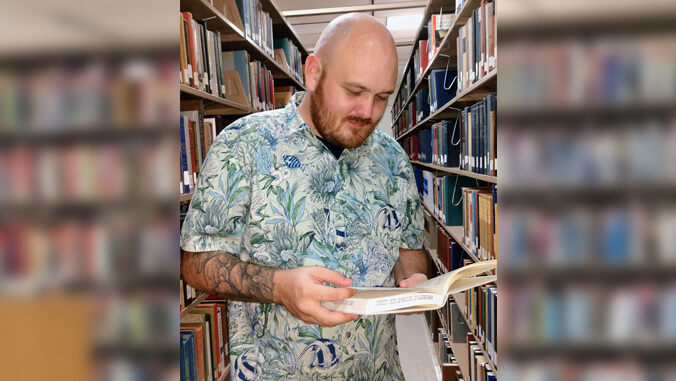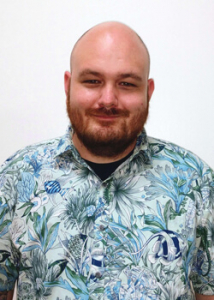
Co-authoring a research study is a significant milestone in any scholar’s academic career, but achieving this as an undergraduate student is an especially remarkable feat. University of Hawaiʻi at Hilo alumnus Ryan Hanoa had the opportunity to contribute as an undergraduate to two published studies that investigate military suicides in the U.S. Army.
“It’s something that I never would’ve dreamed of as a kid,” Hanoa remarked.
Hanoa, a U.S. Navy veteran who graduated from UH Hilo in 2019 with a bachelor of arts in history, conducted research alongside co-authors Jeffrey Allen Smith, UH Hilo professor and chair of the history department, Michael Doidge, chief historian at USAF AFTC, and B. Christopher Frueh, UH Hilo psychology professor. Hanoa first joined the team in 2018.
There’s no feeling like coming up with a new idea or an idea that will contribute to future solutions. There’s no adrenaline rush like it.
— Ryan Hanoa
The team worked on two studies. The first, “A Historical Examination of Military Records of U.S. Army Suicide, 1819 to 2017,” was published in December 2019 in the Journal of the American Medical Association (JAMA) Network Open. It compares suicide rates of active duty U.S. Army service members from the early 19th century through the 21st century. The follow-up study, “A Historical Comparison of U.S. Army & U.S. Civilian Suicide Rates, 1900–2020,” was published in Psychiatry Research in March 2023, and suggests that societal and cultural factors play a greater role in military suicides than combat trauma and other war-related causes.
Learn more about the studies in UH News:
- UH Hilo researchers conduct historical study of suicide in Army, December 13, 2019
Military, civilian suicides driven by societal factors, not war, April 9, 2023
As a research assistant, Hanoa’s early responsibilities included examining U.S. Surgeon General’s reports and pulling data, which he then plotted into graphs for Smith, Doidge and Frueh. What defined his role as a co-author, however, were the extensive discussions and analyses that he participated in outside of his data gathering.
“I will always remember the moment of epiphany, that combat isn’t a primary driving factor,” said Hanoa. “It’s something that is repeated so very often in academia, that you kind of take it as a given. But that moment when you realize that there is a conclusion to be had that’s different—there’s no feeling like coming up with a new idea or an idea that will contribute to future solutions. There’s no adrenaline rush like it.”
UH Hilo ‘provides the brainpower’

Hanoa was born in Hilo, Hawaiʻi and spent his early childhood in Kaʻu, the southernmost district of Hawaiʻi, before moving to Puna. He joined the Navy in 2004 after attending Hawaiʻi Community College and earning his GED from the Hilo School for Adults in late 2003.
After serving in the Navy, Hanoa was inspired by the eldest of his three sons (currently ages 14, 13 and 7) to go back to school. He chose the history program at UH Hilo because the subject posed the greatest intellectual challenge for him, which would also serve as inspiration to his son, who was in second grade at the time. It was during this undergraduate program that he first got involved with the military suicide research in 2018. After discussing Hanoa’s goals to delve further into academic writing and research, Smith invited Hanoa to join his study.
Hanoa explained how opportunities like his, though typically rare for undergraduates, are fostered through UH Hilo’s tight-knit campus community and its professors who open their doors to discussion and guidance outside of class.
“My whole experience at UH Hilo has always been that it goes as far as I want it to go,” said Hanoa. “I’ve never had a professor close their door on me or wave me off. The school provides all of the brainpower— you just need to go there and tap into it.”
Veteran perspective
As a Navy veteran, Hanoa has a personal investment toward research on military suicide. His years working in information technology for the Navy shaped his perspective toward the topic, as he experienced firsthand the high-stress situations that military personnel endure. Even after exiting the military, many veterans experienced difficult transitions back to civilian life. The topic hits close to home for Hanoa, whose close friend had passed away due to challenges he experienced as a transitioning service member. For Hanoa, the goal of helping other veterans like his friend remains a driving mission behind his research.
“Anything that could help with that transition period—anything that could save other veterans—is a mission of mine,” said Hanoa.
Solution-driven research
Hanoa intends to continue his research with Smith and Frueh, with plans to expand the study to other branches of the military, particularly the Navy, Marines, and the Air Force. The team also hopes to include a greater focus on women and minorities—something that they strived to do with the previous studies, but couldn’t quite achieve thus far due to limited available data.
“We plan to expand the kind of data we’re collecting because we want to produce evidence for people to look at when they’re talking about their concepts of solutions,” said Hanoa. “This is not the end result. This is a set of data that leads to solutions.”
—By Alisha Churma

